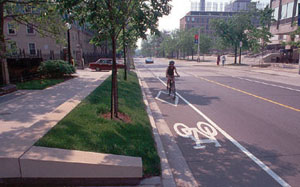Road Diets Fixing the Big Roads (15 page pdf, Walkable Communities, Inc. March 1999)
Also discussed here: Applying the Road Diet for Livable Communities (20 slides, ITE, 2005)
And here Summary Report: Evaluation of Lane Reduction "Road Diet" Measures and Their Effects on Crashes and Injuries(6 page pdf, Highway Safety Information System, US Dept of Transportation)
And here: Road diet (Wikipedia)
And here: The Benefits of a “Road Diet” (StreetsBlog, May 3, 2007)

One well recognized axiom of road design is that the wider they become the more traffic and congestion can be expected. The counter to this is to improve traffic flow not by widening the roads but by reducing their width and lanes- a concept called “Road Diet”. Results show fewer fatalities form crashes and one might expect lower emissions as a result of less congesiton and the idling that accompanies stalled traffic. The replacement of vehicle lanes with cycling lanes also contributes to a less polluting city and safer riding for cyclists. Pedestrians too are safer not having as wide a street to cross as before, with a safe median as a refuge in the middle of the road. Is the four lane road an antiquated design whose time has come and gone?
Key Quotes:
““Road dieting” is a new term applied to “skinnying up” patients (streets) into leaner, more productive members of society. The ideal roadway patient is often a four-lane road carrying 12-18,000 auto trips per day”
“Pedestrians have rugged times finding gaps across four lanes. Crash rates and severity of conflicts with autos result in almost certain death (83% of pedestrians hit at 40 mph die)”
“Researchers have found that road diets can be expected to reduce crashes by 6% to 29%”
“The change can increase value of existing properties. In some cases costs of reconstructing roadways are repaid in as little as one year through increased sales tax or property tax revenue”
Best places to start:
- “Moderate volumes (8-15,000 ADT)
- Roads with safety issues
- Transit corridors
- Popular or essential bicycle routes/links
- Commercial reinvestment areas
- Economic enterprise zones
- Historic streets
- Scenic roads
- Entertainment districts
- Main streets”
“In Toronto, we have removed traffic lanes on approximately 18 km (12 miles) of downtown streets (eight different streets) to provide bike lanes. These routes represent about two thirds of our existing bike lanes”
“We have a project in Ottawa where a bridge is being reconstructed. The original cross-section included two HOV (buses only) lanes and four car lanes (2 in each direction). The new cross-section includes two HOV buses only) in the outside lanes, then two car lanes and two bicycle lanes (one in each direction). A median was also added. In essence, two car lanes were given over to bicycle lanes and a median”
Related articles
- Greenwood Avenue North goes on a 'road diet' (seattletimes.nwsource.com)
- Getting There: Should Seattle-Shoreline arterial go on a road diet? (seattlepi.com)
- Calling all cyclists - NC meeting tonight to discuss Wilbur Ave road diet and bike lanes (bikinginla.wordpress.com)
- LACBC Talking Points for the City Planning Commission Meeting 11/4/10 (lacbc.wordpress.com)
- Nearby: Dim Sum, muralist, Nickerson 'road diet' (myballard.com)
- Admiral Way restriping will keep existing lanes, city announces (westseattleblog.com)
- Today's post, in which I am truly grateful - and only complain a little (bikinginla.wordpress.com)
- Casting a critical eye on Times columnist Sandy Banks' Wilbur Ave auto-centric bias (bikinginla.wordpress.com)
- Wilbur Ave. - Unfair Representation on Committee (lacbc.wordpress.com)
- Bike Trails for Everyone! (horsesass.org)
- Town Hall in North Seattle, Tonight! (slog.thestranger.com)


No comments:
Post a Comment